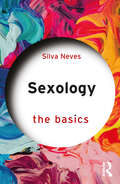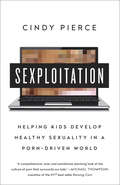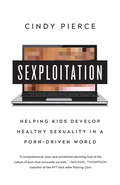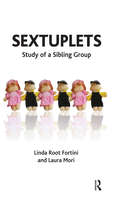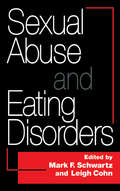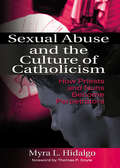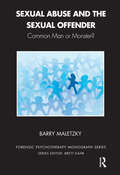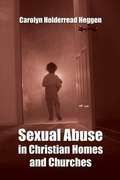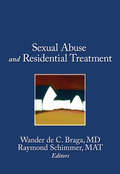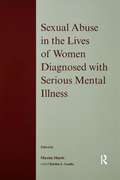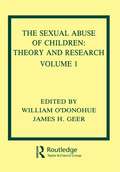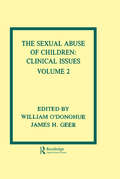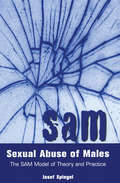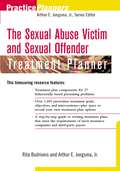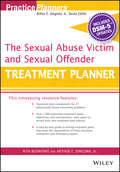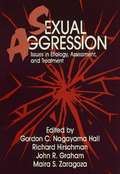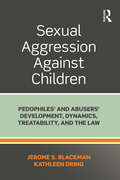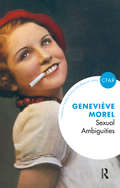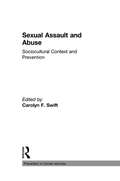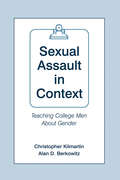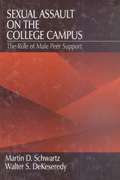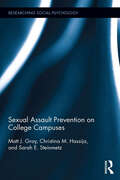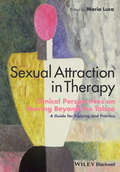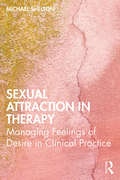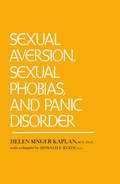- Table View
- List View
Sexology: The Basics (The Basics)
by Silva NevesSexology: The Basics is the contemporary manual of human sexuality, eroticism, and intimate relationships. It takes you to every corner of the human erotic mind and physiological arousal response for a thorough understanding of all the functional parts of our sexualities, including how we bond, love and have sex from a broad perspective of diversities in sex, gender, and relationships, from monogamy to polyamory, Vanilla to Kink. This book bridges the gaps in our knowledge of sex education. It is the ultimate guide to answering all the questions you never dared to ask, whether you are a student or a professional, or want to make sense of our often confusing erotic world.
Sexploitation: Helping Kids Develop Healthy Sexuality in a Porn-Driven World
by Cindy PierceAs surprising as it may be to parents, young people today are immersed in porn culture everywhere they look. Through Internet porn, gaming, social media, and advertising, kids today have a much broader view of social and sexual possibilities, which makes it difficult for them to establish appropriate expectations or to feel adequate in their own sexuality. Parents tend to convince themselves that their children are immune to cultural influences, wait until it comes up, or hope schools and pediatricians will address the issues. Educators and doctors may be able to start the conversation but it is fundamentally a parent's job to provide information about sex and relationships early and often to help young people find their way through their social and sexual lives. Delaying the necessary but awkward conversations with their kids leaves them vulnerable. The media, marketers, and porn and gaming industries are eager to step in anywhere parents choose to hold back. Sexploitation exposes the truth to parents, kids, educators, and the medical profession about the seen and unseen influences affecting children, inspiring parents to take the role as the primary sexuality educator. With more information, parents will gain conviction to discuss and develop values, expectations, boundaries, and rules with their kids. Kids who enter their teens with accurate information and truths stand a better chance of developing an "inner compass" when it comes to sex and relationships, which sets them up for a healthy adulthood. In her comic and straightforward style, Pierce brings together the latest research with anecdotal stories shared with her by high school and college students in the thick of it. Above all else, her goal is to get people to develop more comfort around those difficult conversations so that kids gain more confidence and courage about drawing boundaries based on their own values not those put upon them.
Sexploitation: Helping Kids Develop Healthy Sexuality in a Porn-Driven World
by Cindy PierceAs surprising as it may be to parents, young people today are immersed in porn culture everywhere they look. Through Internet porn, gaming, social media, marketing, and advertising, kids today have a much broader view of social and sexual possibilities, which makes it difficult for them to establish appropriate expectations or to feel adequate in their own sexuality. Even more important, no one is talking to kids directly about the problem. Parents tend to convince themselves that their children are immune to cultural influences, wait until it comes up, or hope schools and pediatricians will address the issues. Educators and doctors may be able to start the conversation but it is fundamentally a parent's job to provide information about sex and relationships early and often to help young people find their way through their social and sexual lives. Delaying the necessary but awkward conversations with their kids leaves them vulnerable. The media, marketers, and porn and gaming industries are eager to step in anywhere parents choose to hold back. Sexploitation exposes the truth to parents, kids, educators, and the medical profession about the seen and unseen influences affecting children, inspiring parents to take the role as the primary sexuality educator. With more information, parents will gain conviction to discuss and develop values, expectations, boundaries, and rules with their kids. Kids who enter their teens with accurate information and truths stand a better chance of developing an "inner compass" when it comes to sex and relationships, which sets them up for a healthy adulthood. In her comic and straightforward style, Pierce brings together the latest research with anecdotal stories shared with her by high school and college students in the thick of it. Above all else, her goal is to get people to develop more comfort around those difficult conversations so that kids gain more confidence and courage about drawing boundaries based on their own values not those put upon them.
Sextuplets: Study of a Sibling Group
by Linda Root Fortini'This unique and fascinating book carefully traces aspects of the personality of sextuplets which persist from birth onwards. The way in which the personal characteristics of both the mother and her children influence the quality of maternal care and relationships with peers is also carefully compared and delineated. What is most original and striking about this book is the examination of sibling group relationships and the description of the sextuplets' early innate characteristics and interactions in early childhood through both psychological testing and infant observations and then shows how specific characteristics and interactions persist through early adult life. It is essential reading for many professionals involved in child development studies including doctors, teachers, psychologists, psychotherapists and health visitors.'- Jeanne Magagna, Phd, Consultant Psychotherapist, Ellern Mede Centre and former Head of Psychotherapy Services, Great Ormond Street Hospital for Children
Sexual Abuse And Eating Disorders
by Leigh Cohn Mark F. SchwartzFirst published in 1996. Routledge is an imprint of Taylor & Francis, an informa company.
Sexual Abuse and the Culture of Catholicism: How Priests and Nuns Become Perpetrators
by Myra L HidalgoAn inside look at the reasons Catholic priests and nuns commit sexual abuseSexual Abuse and the Culture of Catholicism digs beneath the public scandals to explore the underlying causes of sexual abuse by priests and nuns from the unique perspective of an abuse victim/survivor who is an experienced mental health practitioner and social science researcher. This powerful book includes the author’s personal account of sexual abuse by a nun and her years of struggle to recover. Passionate but scholarly and objective, the book advocates the need for healing dialogue, empirical research, and informed prevention strategies to bring a meaningful resolution to the crisis of sexual abuse in the church.Popular explanations for the reasons behind the crisis have included issues related to celibacy, homosexuality, the power structure of the church, and poor seminary screening practices. But none of these theories are supported by research nor can they explain why Catholic priests and nuns may be more likely to abuse children that other adults in positions of trust. Sexual Abuse and the Culture of Catholicism uses a complex, systemic approach to draw parallels between the church as a human system and a family that has experienced incest, presenting a model for a sexual trauma cycle in the church based on systemic sexual shame passed down through the beliefs and practices of Catholicism. Sexual Abuse and the Culture of Catholicism examines: the prevalence and characteristics of sexual abuse by Catholic priests and nuns compared to sex offenders in the general population celibacy, homosexuality, and the power structure of the church as contributing factors in the sexual abuse crisis an analogy of the church as a family in which incest occurs the effects and causes of sexual offending from one generation to the next how current research on sexual offending applies to sexual abuse by priests and nuns healing and empowerment for those affected by religious-based sexual trauma reform and renewal within the Catholic Church and much moreSexual Abuse and the Culture of Catholicism is a unique and important resource for clergy, religious order, and lay leaders in the Catholic Church and other Christian denominations; social science researchers; social workers and mental health professionals; lay and religious members of the Catholic Church; and anyone recovering from religious-based sexual trauma.
Sexual Abuse and the Sexual Offender: Common Man or Monster? (The Forensic Psychotherapy Monograph Series)
by Barry MaletzkySexual Abuse and the Sexual Offender examines the myths perpetuated by the media and widely held by the public, by providing actual data, with case examples, to demonstrate how sexual offending occurs, who commits these acts, what might cause such crimes, how sexual offenders are assessed, supervised and treated, and how to prevent such offending from occurring to the reader or to members of her or his own family. This book is not a textbook on how to assess or treat sexual offenders for a clinical audience. Rather, it aims to educate the general public about how experts in this field diagnose, analyze, assess and treat such offenders and what steps they may take to prevent such abuse in the future. It describes, with actual case examples, how we recognize a variety of offenders, how to separate them and assess their risk, and how to avoid becoming prey to them.
Sexual Abuse in Christian Homes and Churches
by Carolyn HeggenThis book by a psychotherapist specializing in sexual abuse confronts harsh realities. But Dr. Heggen also offers hope that confronting broken sexuality will bring healing for survivors of abuse, for perpetrators, for the church.
Sexual Abuse in Residential Treatment
by Mat Raymond Schimmer Wander BragaSexual Abuse in Residential Treatment provides comprehensive information on behavioral manifestations of sexual abuse in residential settings and the safety and developmental needs, staff training, and management strategies necessary to protect both residents and staff. Chapters containing vivid case studies that describe problematic episodes, discussions of research projects, and proposals for agency sexuality policies, safe facility management, and staff training contribute to a balanced presentation of the framework in which sexual manifestations are embedded.Professionals in residential treatment will learn how to identify the most common sexual, sexualized, and sexually abusive behaviors and from whence they derive. Sexual Abuse in Residential Treatment provides specific suggestions for policy and program design, recommends operational framework for safe management of treatment facilities, and describes practical staff supervision and training modules. With an emphasis on clinical practice, descriptions of common problems and proposed solutions together with a broad philosophical basis to guide policy setting will benefit professionals in agencies interested in developing customized organizational and treatment plans. Practitioners, policymakers, and decision makers in residential programs, inpatient psychiatric units, community-based group homes, court-related youth shelters, and correctional facilities for the rehabilitation of behaviorally disturbed youth presenting sexual problems will find a wealth of information on a wide range of topics such as: normal, pathological, and abusive sexual behavior in residential treatment staff responses to sexual behavior, training, and supervision needs frequency and quality of sexual behaviors of latency-aged children safe management to prevent toxic manifestations of sexuality management of sex abuse allegations in the residential program recommendations for agency sexuality policies selection criteria and program features for specialized offender treatment the heterogeneity of phenomena classified as “sex abuse” values conflicts involved in the design of programs and policiesSexual Abuse in Residential Treatment provides descriptive commentary concerning sexual behavior of youth in residential treatment from various points of view including development, values, therapeutic milieu, safety, training, and clinical experience. Such a diverse approach makes this a valuable guide for practitioners, as well as program directors, unit supervisors, case managers, staff trainers, faculty in child care studies, and child protective services staff.
Sexual Abuse in the Lives of Women Diagnosed withSerious Mental Illness (New Directions In Therapeutic Intervention Ser.)
by Maxine Harris Christine L. LandisAlthough a substantial amount of media and professional attention has been devoted to the incidence of sexual abuse in the population at large, the plight of those who have suffered abuse and are seriously mentally ill has largely been ignored. Adding to the existing literature on trauma, this book exposes the prevalence of physical and emotional abuse among severely mentally ill patients, and includes case studies that reveal its tragic and devastating impact. Offering chapters on theory and assessment of abused women, this book explores services that are available to them, discusses treatment (including inpatient and cognitive-behavioral approaches), and addresses recommendations for the improvement of both policy and research.
The Sexual Abuse of Children: Volume I: Theory and Research
by William O'Donohue James H. GeerThe sexual abuse of children is now seen as an enormous problem; first, because there is an increasing awareness that it is more prevalent than previously thought, and second, because it gives rise to so many complex questions. How is sexual abuse to be defined? What are the effects of abuse? How can the victim be helped? How can abuse be prevented? These two comprehensive volumes cover a wide spectrum of basic and applied issues. Expert contributors -- including physicians, attorneys, psychologists, philosophers, social workers, and engineers -- address such relevant topics as epidemiology, animal models, legal reforms, feminist scholarship, child pornography, medical assessment, and diverse models of psychotherapeutic intention.
The Sexual Abuse of Children: Volume II: Clinical Issues
by William O'Donohue James H. GeerThe sexual abuse of children is now seen as an enormous problem; first, because there is an increasing awareness that it is more prevalent than previously thought, and second, because it gives rise to so many complex questions. How is sexual abuse to be defined? What are the effects of abuse? How can the victim be helped? How can abuse be prevented? These two comprehensive volumes cover a wide spectrum of basic and applied issues. Expert contributors -- including physicians, attorneys, psychologists, philosophers, social workers, and engineers -- address such relevant topics as epidemiology, animal models, legal reforms, feminist scholarship, child pornography, medical assessment, and diverse models of psychotherapeutic intention.
Sexual Abuse of Males: The SAM Model of Theory and Practice
by Josef SpiegelThis comprehensive text is one of the first to tackle the grave matter of the sexual abuse of boys, in all its complexity, within a biopsychosocial context and from different vantage points. Based on the life histories of more than one thousand sexually abused boys and adult males with histories of childhood sexual abuse, Sexual Abuse of Males examines the myriad biological, psychological, interpersonal, familial, and social variables that underlie and impact the experience of childhood sexual abuse. Guided by research and informed by practice, this pioneering text presents an extensive review of the literature, a well-grounded theoretical model of abuse dynamics and effects, a systematic model of treatment. This information is further elucidated through compelling case illustrations that highlight the effects of sexual abuse with regard to biological, psychological, and social adaptation, and development.
The Sexual Abuse Victim and Sexual Offender Treatment Planner
by Rita Budrionis Arthur E. Jongsma Jr.The Sexual Abuse Victim and Sexual Offender Treatment Planner provides all the elements necessary to quickly and easily develop formal treatment plans that satisfy the demands of HMOs, managed care companies, third-party payors, and state and federal review agencies. Saves you hours of time-consuming paperwork, yet offers the freedom to develop customized treatment plans for clients who are sexual abuse victims and/or sexual offenders Organized around 27 main presenting problems, including such offender issues as anger difficulties, deviant sexual arousal, and legal issues; such victim issues as eating disorders, self-blame, and social withdrawal; and such offender and victim issues as family reunification and self-esteem and stress-management deficits Over 1,000 well-crafted, clear statements describe the behavioral manifestations of each relational problem, long-term goals, short-term objectives, and educational interventions Easy-to-use reference format helps locate treatment plan components by behavioral problem or DSM-IV-TR(TM) diagnosis Includes a sample treatment plan that conforms to the requirements of most third-party payors and accrediting agencies (including HCFA, JCAHO, and NCQA)
The Sexual Abuse Victim and Sexual Offender Treatment Planner, with DSM 5 Updates (PracticePlanners)
by Arthur E. Jongsma Jr. Rita BudrionisThis timesaving resource features: Treatment plan components for 27 behaviorally based presenting problems Over 1,000 prewritten treatment goals, objectives, and interventions—plus space to record your own treatment plan options A step-by-step guide to writing treatment plans that meet the requirements of most insurance companies and third-party payors The Sexual Abuse Victim and Sexual Offender Treatment Planner provides all the elements necessary to quickly and easily develop formal treatment plans that satisfy the demands of HMOs, managed care companies, third-party payors, and state and federal review agencies. Saves you hours of time-consuming paperwork, yet offers the freedom to develop customized treatment plans for clients who are sexual abuse victims and/or sexual offenders Organized around 27 main presenting problems, including such offender issues as anger difficulties, deviant sexual arousal, and legal issues; such victim issues as eating disorders, self-blame, and social withdrawal; and such offender and victim issues as family reunification and self-esteem and stress-management deficits Over 1,000 well-crafted, clear statements describe the behavioral manifestations of each relational problem, long-term goals, short-term objectives, and clinically tested treatment options Easy-to-use reference format helps locate treatment plan components by behavioral problem Includes a sample treatment plan that conforms to the requirements of most third-party payors and accrediting agencies (including HCFA, JCAHO, and NCQA)
Sexual Aggression: Issues In Etiology, Assessment And Treatment (Issues in Etiology of Assessment and Treatment Series)
by Donald HallFirst published in 1993. Routledge is an imprint of Taylor & Francis, an informa company.
Sexual Aggression Against Children: Pedophiles’ and Abusers' Development, Dynamics, Treatability, and the Law
by Jerome Blackman Kathleen DringIn Sexual Aggression Against Children: Pedophiles’ and Abusers' Development, Dynamics, Treatability, and the Law, Drs. Blackman and Dring use multiple psychoanalytic principles to answer, “Why do people sexually abuse children?” and “Why are most abusers male”? They address the legal and mental health professions’ minimization of the horrific nature of child sexual abuse, explain how to assess pedophiles’ treatability, and discuss cases of adolescent and adult predators. Also, developmental analysis of sexual predation is integrated with a review of judicial decisions regarding civil commitment and punishment of abusers. The authors suggest how courts, evaluators, and legislatures can preserve constitutional rights of sexual offenders while prioritizing protection of children.
Sexual Ambiguities (The Centre for Freudian Analysis and Research Library (CFAR))
by Genevieve MorelHow does one become a man or a woman? Psychoanalysis shows that this is never an easy task and that each of us tackles it in our own, unique way. In this important and original study, the author focuses on what analytic work with psychotic subjects can teach us about the different solutions human beings can construct to the question of sexual identity. Through a careful exposition of Lacanian theory, the author argues that classical gender theory is misguided in its notion of 'gender identity' and that Lacan's concept of 'sexuation' is more precise. Clinical case studies illustrate how sexuation occurs and the ambiguities that may surround it. In psychosis, these ambiguities are often central, and the author explores how they may or may not be resolved thanks to the individual's own constructions. This book is not only a major contribution to gender studies but also an invaluable aid to the clinician dealing with questions of sexual identity.
Sexual Assault and Abuse: Sociocultural Context of Prevention
by Robert E Hess Carolyn F SwiftPrevention of a chronic societal problem such as sexual victimization requires looking beyond individuals to the systemic factors that maintain the problem. Sexual Assault and Abuse addresses the need to change social and cultural beliefs and practices that permit the sexual victimization of women and children. Potential rapists and victims are viewed within the context of the social and cultural factors that shape sexual behavior. The book discusses rape prevention approaches ranging from changing individuals and groups to changing the social and cultural factors that permit and promote sexual victimization.Research in the social sciences, in education, and in the media documents the promise as well as the problems with efforts to change social and cultural beliefs and practices to create a sexually safe society. Sexual Assault and Abuse integrates recent advances in research on sexual assault and prevention into strategies to prevent sexual victimization, with a focus on the role of sociocultural factors.In Sexual Assault and Abuse, editor Carolyn F. Swift brings together authors who thoughtfully examine the perpetrators and victims of sexual assault/abuse in an effort to change or obliterate sociocultural factors which maintain or promote this behavior. Topics covered include: the sociocultural context of sexual assault/abuse the need to develop multiple-level prevention programs development of sexually abusive behavior in men and boys the relationship between pornography and sexual assault/abuse the need for culturally-sensitive prevention programs the significance of sexual revictimization in the lives of African American women an ecological approach to the prevention of sexual harassment utilization of social science research to develop public policy on pornography use of public information campaigns to prevent intrafamilial child sexual abuse within Hispanic familiesSexual Assault and Abuse identifies sociocultural risks associated with sexual assault/abuse and explores ways to reduce these risks, from a prevention perspective, for diverse populations. Risks addressed include gender inequities, pornography, worksites hostile to women, previous victimization in African American females, sexist and racist beliefs, and media violence against women. Prevention programs range from interventions to stop the development of sexually abusive behavior in boys and men, through programs that take account of ethnic diversity in language, history, and culture, to those that promote empowerment of women. By addressing the environmental context in which sexual assault occurs, the authors in Sexual Assault and Abuse broaden their focus to incorporate both potential perpetrators and potential victims in an ecological perspective which permits new approaches to prevention. This book is of special interest and value to academics and practitioners of psychology, psychiatry, and social work, therapists and counselors, women&’s studies professionals, sociologists, anthropologists, feminists, rape crisis center staff and volunteers, and battered women center staff and volunteers.
Sexual Assault in Context: Teaching College Men About Gender
by Christopher Kilmartin Alan D. BerkowitzMost North American colleges have programs that help students understand the harm done to victims of sexual violence and, if prosecuted, the potential consequences of their perpetrators. However, only a few programs also address those aspects of masculine culture that surround sexual assault. Sexual Assault in Context addresses the undesirable aspects of masculine culture that sustains the violation of women and girls. It examines several typically overlooked patterns of behavior that provide the basis for sexual assault and provides an overview of masculine psychological development as a context for sexual assault. The book also includes prevention strategies, information on funding and consultation issues, and additional resources for investigating further into male gender awareness and sexual assault.The text's hands-on, practical approach, helps counseling professionals negotiate educational, organizational, and logistical issues in helping college men understand the gendered context of sexual assault and harassment. This resource is intended to help reduce the incidence of sexual assault on college campuses, as well as help men gain a greater understanding of: cultural gender pressures; relationship skills; their impact on others; and the considerable influence male peer cultures have on how women are treated.Sexual Assault in Context provides an easy-to-read synopsis of male gender and sexual assault education strategies. It is intended as a resource for college counseling and/or violence prevention programs, and for those interested in understanding the psychological and social effects of the current culture of masculinity.
Sexual Assault on the College Campus: The Role of Male Peer Support
by Dr Martin D. Schwartz Walter S. DekeseredyFor many students, coeducational college campus life is marred by traumatic experiences of sexual assault. While there are many social determinants of rape and attempted rape, this work examines the pivotal role of male peer support in legitimizing the sexual assault of women. The authors use extensive prior studies together with their own investigations, including a national representative study and local campus victimization surveys carried out in the United States and Canada.
Sexual Assault Prevention on College Campuses (Researching Social Psychology)
by Matt J. Gray Christina M. Hassija Sarah E. SteinmetzSexual assault continues to be a problem on college campuses despite greater attention to reducing rates of assault and an increased presence in the public discourse. Programming has been historically directed towards women by providing them with information about how to keep themselves safe rather than confronting a climate conducive to sexual violence. This important volume illuminates the urgency of combating sexual violence on college campuses. The authors depict in detail empirically supported approaches to combating climates conducive to sexual violence and ways to empower all members of the campus community to actively prevent sexual violence.
Sexual Attraction in Therapy
by Maria LucaSexual Attraction in Therapy presents new findings from multiple perspectives into the complex phenomenon of sexual attraction in therapy. Detailed clinical examples and strategies from expert contributors demonstrate how therapists can engage with sexual attraction, when it arises, in positive ways that facilitate client progress and ensure appropriate professional conduct. Challenges practitioners to think about sexual attraction as a normal dynamic developing through the unique intimacy of the therapy encounterPresents new findings from research to enrich understanding of the lived experience of therapists and how they confront, avoid, make use of the process of sexual attractionProvides clinical examples to highlight common challenges faced by practitioners, the strategies they use to overcome them and how they normalize the 'taboo' of sexual attraction to make positive use of it in therapyMakes an important contribution to current literature on professional practice, an area of increasing importance as more emphasis is placed on issues of ethics, ongoing supervision and appropriate professional conductExpert contributors include Doris McIlwain, Michael Worrell, John Sommers-Flanagan and Martin Milton
Sexual Attraction in Therapy: Managing Feelings of Desire in Clinical Practice
by Michael SheltonThis accessible book offers effective protocol for engaging in better sexual decision-making in clinical practice. It demonstrates that damaging sexual behaviors are often the result of a process in which a clinician progresses towards the crossing of a client-clinician boundary. <P><P>Sexual Attraction in Therapy explores state-of-the art research from a multitude of related fields and includes sage advice on how to recognize personal risk factors, manage arousal, identify counterproductive sexual behaviors, and use self-talk to exit sexual situations. Sexual boundary violations usually follow a much longer insidious process and the book carefully discusses and highlights the warning signs for clinicians, which can develop into sexual predicaments affecting their lives and those of their clients, their workplaces and colleagues, and the reputation of the mental health field. Chapters provide essential guidance so that therapists can monitor progress along the ‘sexual decision cycle’ and, importantly, create organizations far more resistant to poor sexual decision-making. <P><P>This text is an excellent teaching guide for clinicians and treatment professionals who seek therapeutic growth for both clients and themselves. Clinicians will be able to improve their decision-making and prevent themselves from engaging in damaging sexual behaviors, and organizations can redesign their approach to include preventative practices.
Sexual Aversion, Sexual Phobias and Panic Disorder
by Helen Singer KaplanFirst published in 1987. Routledge is an imprint of Taylor & Francis, an informa company.
